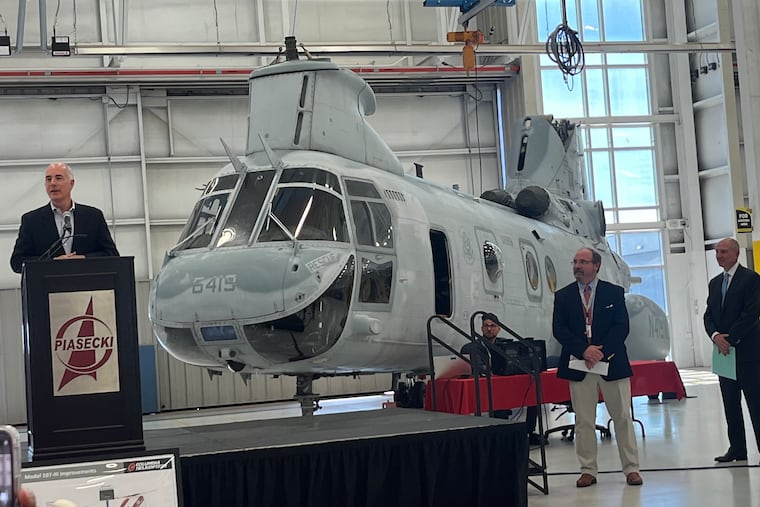Piasecki to hire hundreds for helicopter upgrades in Coatesville
Ukraine War and Russia sanctions raise demand by U.S. allies, CEO says

Around 200 of the workers Piasecki Aircraft Corp. plans to hire at its new “Heliplex” in the former Sikorsky factory near G.O. Carlson Airport will rebuild Vietnam-era CH-46 helicopters for military and civilian use by the U.S. and allied nations, chief executive John W. Piasecki said Tuesday.
The first helicopter is to be delivered this year, six more next year. Piasecki spoke at a luncheon to announce the venture at the plant in Sadsbury Township, near Coatesville, Chester County.
The work will be done in partnership with Columbia Helicopters of Aurora, Ore., which plans a similar number of hires, said Columbia chief executive David Balevic, who joined Piasecki, U.S. Sen. Bob Casey (D., Pa.), and other officials at the event.
Piasecki so far has hired 31 engineers and technicians in Coatesville since agreeing to buy the facility last year. The company expects to eventually employ at least 400, including those who will work on the upgrades. The CH-46, officially the Sea Knight, is well known to Marine Corps veterans as the Phrog.
Piasecki said the Russia-Ukraine war had prompted “new demand from our allies” for heavy-lift helicopters.
Aging Russian-built helicopters in the arsenals of former Soviet-allied states “can’t operate because of the lack of parts, due to Ukrainian War sanctions,” Piasecki added. “This has opened a window for Columbia and Piasecki to reestablish” a program to update those helicopters.
He said Casey and other Pennsylvania representatives in Congress had pressed the military to support new helicopter research and help allies buy U.S.-made helicopters. Casey said military industries are important to U.S. national security and manufacturing employment.
The updated helicopters, Columbia Model 107-III, will include more powerful engines, glass cockpits, and improved autopilot, rotor and fuel systems.
Piasecki will remove old transmissions, rotors, and other components, ship them to Oregon for refurbishment, and install new wire and cockpit systems, along with the refurbished equipment, then paint and test the upgraded helicopters.
The move comes as Boeing’s heavy-lift helicopter division, which still makes and upgrades CH-47 Chinook helicopters, the larger, Army cousin of the CH-46, at plants in Ridley Park, Delaware County, and in Arizona, has been lobbying for more military orders to keep from closing its Chinook and Osprey production lines. (Osprey, with its tilt-rotor construction, is a successor to the CH-46.)
Boeing’s design unit, Piasecki, the Leonardo helicopter factory in Northeast Philadelphia, and other helicopter and parts makers have been lobbying for government contracts to develop unmanned, electric and hydrogen-powered aircraft as drone warfare has threatened to make familiar U.S. and foreign military equipment obsolete and sparked interest, and U.S. funding, for new designs.
The companies have a shared history. Piasecki Aircraft was founded by Philadelphia-born Frank Piasecki, a University of Pennsylvania and New York University grad who started building helicopters for the U.S. Navy during World War II, and is still controlled by family members.
His team designed dual-rotor aircraft. Boeing purchased the business in 1960 and built helicopters for use in the Vietnam War, first at the former Vertol plant in Morton, Delaware County, then at the current Ridley Park complex between the Delaware River and I-95. That plant now employs around 3,500 and continues to update Chinooks for the Army, Air Force, Special Forces, and allied militaries.
Columbia founder Wes Lematta bought surplus helicopters, built by Boeing in Delaware County, as the U.S. scaled down forces in Vietnam in the early 1970s. Columbia eventually licensed what it calls the Model 107 line of helicopters based on Boeing’s airframes. Scores of old CH-46s are stored at an Air Force base in Arizona and are available to upgrade, according to Columbia.
That company operated six Model 107-II helicopters for the U.S. in Afghanistan and has also sold and serviced the helicopters for use in the Philippines, South Korea, and Switzerland, Balevic said. But production of those helicopters had trailed in recent years, before the recent interest.
Piasecki and Balevic said their partnership would build a new Model 107-III helicopter. “We will transform the heavy-lift helicopter industry worldwide,” Balevic said, promising “more fuel efficient, powerful, and robust” aircraft “for decades to come.”
Piasecki said last year that it hoped to eventually employ 400 in all at the 219,000-square-foot Heliplex near Coatesville, while keeping its Essington headquarters and development center open as well.
The Columbia project will account for about half of the projected staff. Piasecki also presented models of alternate-fuel and training aircraft it has been working on and hopes to build at the Heliplex.
This story has been updated to make clear the difference between the CH-46 “Phrog” formerly used by Marines and the larger CH-47 Chinook used by the Army and other forces.